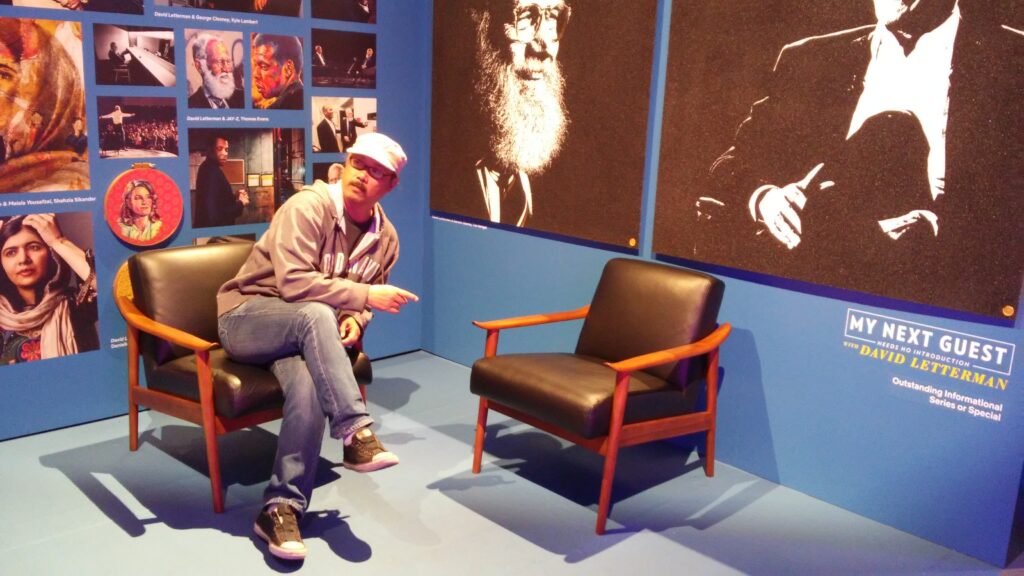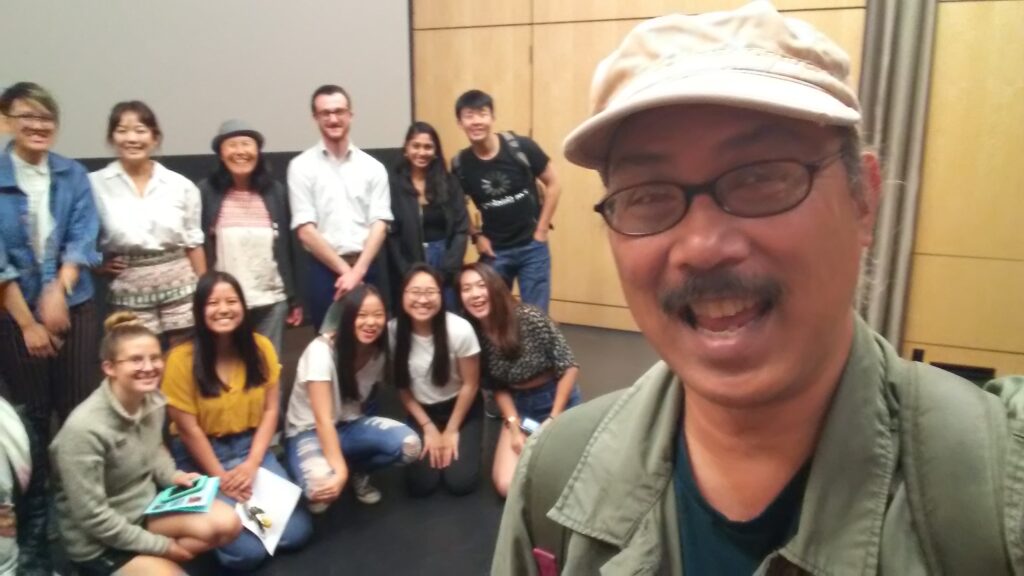Whichever way they choose, an observer must apply some skills of their own to the experience, just as the artist must apply their skills and experience to creating the work in the first place. In this sense audience techniques are parallel to the artist’s techniques, but on the other side of the fence of the work of art: they are an active rather than a passive response to the process, a response that acknowledges that just as the artist puts great effort into acquiring their skills and expressing their talent, so the audience must respond in kind. I am not suggesting for a moment that everyone needs an art degree before they are capable of understanding art. But I certainly am suggesting that some investment in time, and an openness to perceptual refinement, will be richly rewarded. A quick YouTube search will reveal several films of him [Jackson Pollock] working, which will help to understand the thoughtful process involved, and to see that although apparently unstructured to the unknowing eye, there is a great deal of composition involved: layering of contrasting colours, balancing of thin and thick lines. By such simple means we can learn to see these processes and follow them. We can understand their inner meaning and their power to communicate; we can learn the language of line, to get what Pollock is ‘saying.
Hugh Moss, “The Art of Understanding Art: A New Perspective,” 2015
In 2007, Abraham “Abe” Ferrer wrote on his blog about how independent film artists, cultural workers, and festival organizers and even Asian Pacific media arts organizations are the ones who might be behind the curve in the use of internet (YouTube, Podcasts, ITV) and how that might lead to irrelevance from them being unable to connect with digital audiences.
He recalled the experience of viewing music videos with a live audience and the gratification he felt when he saw filmmakers accept the challenge of filling Directors Guild of America (DGA) Theater One with audiences. He wrote then: “the shriek of collective joy that reported the announcement of Charlie Nguyen’s THE REBEL as the winner of the Festival Grand Jury Award at Closing Night; and the relief of watching it all shut down after eight days, 161 productions and nearly 16,000 guests; and [I] can’t help but think, we did pretty good.”
For 32 years, this informed sensibility towards communities is what drives his present work: “the programming and curatorial acumen [that] still apply to various areas of [Visual Communications (VC)], particularly VC’s Asian Pacific Photographic and Media Archive which I oversee here, and how we activate the holdings here in the service of film and digital media productions. For example, gauging the pertinence of particular films to present in a program from our filmography, or deciding what images would be best for a photographic exhibit that we may be working on.”
This writer was granted an interview on Nov. 15, 2017 with Abe as to the community-engaged process that he sustained in curating film festivals for 32 years, as well as the internal process of choosing films in the festival, which has attracted a consistent base of support in the thousands, now in its 34th year in 2018 and looking ahead to VC’s 50th anniversary in 2020.
He credited the festival’s success to a multi-generational, dedicated parade of entertainment workers, artists and just plain people, of which a very very small sampling of the program committee members over the years included: Kimberly Yutani (Director of Programming at the Sundance Institute), Chris Tashima (Academy-award winning director of best live action short film, Visas and Virtue), James Herr (formerly of Sony Studios, now a non-profit consultant), Phil Yu (blogger of Angry Asian Man), Traci Kato-Kiriyama (founder of Tuesday Night Café), and Eric Wat (former UCLA coordinator of Student/Community Projects), among many others.
Abe is quick to share credits of any organizational success with his colleagues and associates. The success is attributable to longtime Visual Communications staffers and associates through the years – like Steve Tatsukawa, Linda Mabalot, Leslie Ito, John Esaki, Jerome Academia, David Magdael, Anderson Le, Chanel Kong and Cheryl Yoshioka.


He said, “We have not populated the programming team with film snobs and instead, those that reflect our audience and what is important to them.”
I was then a programming committee member for a season in VC where I raised what I considered the line in the sand between nudity as part of an organic story of an artist, like a painter who has a portfolio of creation, boys playing in the ocean, encased woman inside a diamond and a nude female body and gratuitous nudity where there is no context for the sexual scenes depicted and I vehemently called pornography. That became a critical discussion for the committee as certain community members’ identities are defined by sexual orientations first before their identities as artists, writers, filmmakers, teachers, students, business owners – do we now censor their artistic products?
The committee derided the film as amateurish, incompetent effort by an academic whose approach to a timely issue lacked cinematic and intellectual rigor. It was a question left for the audience to resolve.
In subsequent festival offerings, I watched one film illustrating nudity as part of an artists’ story and less about sexual tendencies without a context. I felt my own perspective has been challenged, perhaps even encouraged to make me want to immerse more in what is art, what appeals to the audience, or what is simply a shallow effort of self-expression – all those came out of volunteering in VC’s program committee – an ancillary benefit of enlarging even my own perspectives and beliefs, which I had incorrectly thought at that time was open to diversity of ideas, yet had not in practice.
“What drives your moral compass?”
That was a question I posed to Abe, how do you get a multi-year festival that has appealed to multi-generational tastes and still appeal to the immigrants’ soul story in three decades plus?
“That’s huge,” he said.
As consumer and supporter of the festival for three decades, with more than familiarity, that also includes being part of the short films program committee for one season, I credited the festival for my sustained “wokeness.”
Wokeness is now defined as a quality of being aware of social justice issues.
In watching “Heart of the Sea” by Rell Sun, a professional surfer renowned worldwide, I became aware of her 15 years’ quest for cancer cures. She continued to thrive by accepting her local community’s support, but also a social purpose of contributing towards oncology patients’ future efficacious cures, even if she herself could not.
As also, the “Mele Murals” a documentary made by Tad Nakamura making us aware that graffiti art was about the search for identity, while illustrating how a Hawaiian community was formed over the painting of this mural, who engaged their elders, and engaged Mother Nature’s guidance through meditation.
“Linsanity” was a documentary on Jeremy Lin whose ascent to the mainstream sports world created such vibrant energies that I even got to watch it with my two adult children, whose identities are tied to Asian American awareness.
These three films have created an awareness larger than the ‘ghetto confinements of Filipino social issues,’ as Abe would describe, at least from this writer’s personal experience, as her children’s.
Pan Asian American awareness
Pan Asian is a state of awareness that refers to one’s sensitivities affected not just by one’s ethnic origins, but also the larger interests of all.
Abe described a progressive ecosystem which formed the context of raising his awareness, a period wherein there was an alignment between UCLA’s Student/Community Projects and the non-profits in the community like Asian American Drug Abuse Program (AADAP), Asian American Volunteer Action Committee, Chinatown TeenPost, Search to Involve Pilipino Americans (SIPA), towards “creating a laboratory which will partner with organizations and give the students an open education on how to apply what they learned to real-world issues like teen pregnancies, gangs and drug abuse, for me, how my art education informed my work.” In addition, Abe noted he “was influenced by the work Miles Hamada was doing through the Little Tokyo Arts Workshop.”
He described how he was a passive observer of events, rather than an active participant.
He witnessed how in 1978, following the UC Regents being sued by Allan Bakke, who claims he was “reverse discriminated” at UC Davis School of Medicine. That landmark decision of the U.S. Supreme Court affirmed affirmative action allowing race as one of the several admission factors but setting aside specific racial quotas, like 16 out of 100 seats were impermissible.
Allan Bakke, an engineer and a former U.S. Marine Corps officer in his 30s, sought admission and was turned down. The decision resulted in Bakke being admitted and also led not just a fracturing of the Supreme Court, but also grassroots campus organizing, like the creation of Asian Pacific Student Union. Abe recalled that it started the aligning of West Coast issues, like the redevelopment movement, the Japanese American redress and even Justice for Chol Soo Lee, the building of the infrastructure around the Far West Coast Convention.
Abe’s interview reflected an Asian American awareness of what is going on; from the time he was pursuing a Bachelor’s in Fine Arts Degree at UCLA to his aspiration of becoming a visual artist, to his life’s work actualizing that aspiration.
Donning his beret and a jacket, the casually dressed VC’s Los Angeles Asian Pacific Film Festival director, sat down with this writer at LA Rose Café. When I was about to introduce him to the owner, Lem Balagot, Abe acknowledged that they have met. Abe is now the Digital and Distribution Manager of the Asian Pacific American Photographic and Media Archives, or VC Archives for short.
He traces his introduction into VC when Juliet Masculino was wrestling with a project, “MANONG,” one of the four films that were part of a Pan-Asian American Hidden Treasures Series that received a grant from the Department of Education. Juliet was then the roommate of Abe’s best friend, Thelma Custodio. Juliet was materially involved with helping to produce “MANONG,” as well as managing her role within VC as the organization was becoming involved with Little Tokyo redevelopment struggles, while the project director of “MANONG” was then Linda Mabalot.
He described the synergy of what he knows and the respect he has of what is being defined as culture and communities by the grassroots. In the Festival, for example, their open call generates about 500 to 600 submissions, to which only about a dozen or so will be categorically rejected as “bad.”
Most of the time the entries are distinguished and makes the program committee’s job more difficult. “It means increasingly good films are being made but our programming slots are limited.” Add to that, the quantity of works submitted and/or solicited each year has climbed to nearly 800 or so feature-length and short submissions.
The synergies of art, culture and communities
Communities are largely defined by a fellowship of folks sharing the same interests, goals and attitudes.
“That communities around festivals can determine support and encouragement for diverse artists, as well as dictate what is being produced and the direction for that viewing season, what perspectives externally and what’s happening in the world can all inform what people are creating,” Abe continued describing the synergies of art and culture.
It also means that they have a shorter window of selection from the Sundance in January to what is picked up by major studios, Abe said, “there is a shorter period given the film studios need to recoup their investments, and with Netflix and Amazon, that window is even made shorter, 30-45 days to put up films for screening, though streaming stays up longer than the theatrical run.”
The festival he managed for 32+ years will now be on its 35th year in 2019. The workshops continue to be well-attended as Asians are cast in center stages talking about diversity issues while providing forums to discover, to incubate and to showcase the community’s emerging artistic talents.
The festival is a “home,” a reliable cultural space for artists, a “major tastemaking event,” such that the Academy has qualified this festival as a pipeline for short films and a reunion of past to present Asian Pacifics involved in community building using the arts and social awareness.
“Festival No. 34 maintains our spirit of producing this annual showcase through the process of creating our ideal communities,” states VC Executive Director Francis Cullado on 2018’s LAAPFF, “Our programmers and staff imagine our ideal communities to be inclusive while striving towards equity and change. And with regards to the ongoing discourse about diversity, we aim to have a space that engages intra-diversity amongst AAPIs and inter-diversity with other communities and groups. We at Visual Communications (VC) and this Festival proudly present a slate of artists and creators who continue to shift narratives and challenge perspectives.”
2018 gave festival attendees an early chance to see John Cho and Debra Messing in “Searching” via Sony Green Gems, which was co-written and directed by Aneesh Chaganty, a first-time feature filmmaker.
Abe’s programming and cultural acumen have now switched to digital management of VC’s archives. His articulation of their dynamic programming committee’s criteria converged with what I read: “Has my involvement in the process, of which this particular art object [film] is part, raised my consciousness in any way?” Whatever the answer to that question, the fact that we can ask it gives art [film] a new life. With the full emancipation of art, we must also allow it the freedom to do anything and, more to the point, to say anything: to have free speech, if you like but also to have freedom of expression in the languages beyond speech,” Hugh Moss, one of London’s leading 20th century dealers in Asian art who represented the best Chinese artists in Hong Kong, and who wrote “The Art of Understanding Art: A New Perspective” (2015).
I recalled how Abe oriented his selection committee volunteers to consider we had a much larger impact, an impact that transcended our individual tastes even our narrow perspectives, and that our assessments would later inform the program committee’s decisions, who made their final selections. He marshaled professionalism to be our work styles, and emphasized the importance of our community-directed mission.
In viewing the shorts, we understood that they were more than artifacts, they were more than entertainment sources, and if they pass the screening criteria, they acquired a community recognition value on awards night, validated by evaluation forms from the viewing audience.
“We are always playing catch-up to the formations of communities,” Abe said, “how Indian Americans came to see themselves as part of that [Asian American] framework, although geographically, would be Southeast Asians. Perhaps, a final frontier wherein we place the Asian continent in the western part.”
Abe shared that the festival has endeavored to show films from Turkey, Iran and Iraq, as the boundaries of Asian Pacific communities are further redefined.
We switched the discussions to the larger framework of institution building and he highlighted the correct foundations leading to the formation of the Pilipino Workers’ Center, the Larry Itliong building for seniors, those with a clear mission and the need for new blood, as what Kayamanan ng Lahi does with the youth.
Similarly, the institutions that are delivering Asian American health care services that are doing what people have not attempted before and are as “close to the leading edge as possible.”
He shares the formations around FPAC and 626 Night Market in Arcadia “that we now have transit cultures.”
Is Abe articulating the power of culture, created from the ground up, and how relevant culture in reshaping our consciousness? Just like the emergence of the #FilipinoFoodMovement created with the presence of social media influencers in propagating that trend and that art is fluid in reflecting choices, perhaps informed by an Asian Pacific American awareness that has to be grown and enlarged by a broader world’s perspectives?
We see what we do in arts as inseparable, as we have been acculturated through Internet and cable TV, NHK World, Arirang and ABS-CBN. We also have new challenges as arts are informed of anomalies: wage equity, trafficking, equity wages, politics and of late, sexual assaults to the #metoo movement. We are ready to throw out our criteria in favor of a new level of “wokeness,” a political-cultural awareness that does not happen uniformly for people.
Published on Asian Journal
